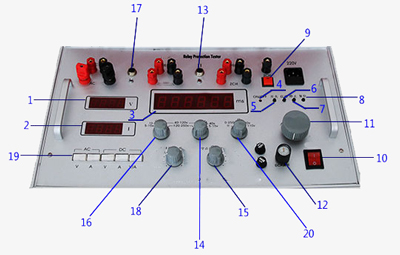Single phase protection relay test equipment consists of a fully isolated dual channel and longtime counting digital millisecond meter, high power AC and DC voltage, current output unit, high precision multi-function AC/DC digital ammeter and voltmeter and logic control, overload protection and signal.
Functions
- The single-phase relay protection test equipment can test various AC/DC, current, voltage, intermediate, self-protection, signal and other single relays and the entire set of electromechanical protection screens.
- The secondary injection relay test kit can test the pull-in voltage (current) value of various relays and release the voltage (current) value.
- The single phase protection relay test kit tests the pull-in and off-time of various contacts (normally open, normally closed, switched, delayed). It can easily test the parameters of the reclosing relay, and can replace the traditional stopwatch as a precision millimeter.

Various parts on the single phase relay tester panel
- Output voltage numerical table
- Output current numerical table
- Digital millisecond meter display screen
- Power output indicator lamp
- Power output ON-OFF key
- Time counting start key
- Counting stop key
- Reset key
- ZCH key
- Power source switch
- Power output adjusting button
- DC current adjusting knob
- CH II input end jack soket
- CH II input end jack socket
- CH II amplitude adjustment button
- CH II channel input selector switch
- CH I amplitude adjusting button
- CH I input end jack socket
- Power output selector key
- DC voltage selector switch; see the marking of the panel for other output wiring terminal
Application
sisco relay tester is mainly used for 6 phase protection relay testing in electric power industry, transformer substation and ship industry, etc.

| Digital Millisecond Meter | Model | SISCO-RT701 |
| Power Supply | 220V 50Hz | |
| Range | 99.9999S | |
| Resolution | 0.1ms | |
| Accuracy | ±0.001%±1 Character | |
| Input Reactance | ≥200kΩ | |
| Input Single Range | Refer to Table 1 | |
| Digital Phase Meter | Scope of Measurement | 360.0 Degrees |
| Resolution | 0.1 Degree | |
| Accuracy | <±1%±1 Character for input signal voltage ≥150mV, current ≥15mA | |
| <1.5%±1 Character for input signal voltage ≥50mV, current ≥50mA | ||
| Digital Voltmeter | AC and DC voltage, digit display, maximum resolution 0.1V, accuracy 0.5%±1 character | |
| Digital Ammeter | AC and DC current, digit display, resolution 0.1A, accuracy 0.5%±1 character | |
| Power Source Output | AC Voltage | 0~250V, continuously adjustable, maximum output power 1,000VA, with short circuit and overload protection, and current limit 4A. |
| AC Current | 0~130A continuously adjustable, maximum output power 1,200VA, with short circuit and overload protection, and current limit 180A. | |
| DC Voltage Output | 0-250V, continuously adjustable, with short circuit and overload protection, and current limit 2.5A. | |
| DC Fixed Voltage 110V/220V Output | Output with AC voltage 0~250V or DC current 0~130A. | |
| DC Current Output | 0~5A, continuously adjustable, with short circuit, and current limit 5A | |
| Ambient Temperature | Temperature ensuring the precision 15~35℃ | |
| Dimension | 440*260*260mm | |
| Weight | 15kg | |
Table 1: Shift gear table of input signal amplitude
| Input Signal Amplitude (V) | 5-15 | 15-40 | 40-120 | 120-250 |
| Trigger Voltage (V) | 2.5±20% | 7.5±25% | 20±25% | 60±25% |
| Reliable and Non-Operating Voltage (V) | 2 | 4 | 16 | 48 |
Q1: What is a relay tester?
A1: Relay tester is an important test tool to ensure the safe and reliable operation of power system. With the continuous expansion of the scale of modern power systems and the continuous improvement of the reliability and efficiency requirements of power system operation and management, the testing work of relay protection personnel has become more frequent and complex. The relay protection tester uses a high-performance industrial computer as the control computer, and directly runs the Windows operating system. The back panel of the device is provided with USB ports, network ports, serial communication ports, etc., which can facilitate data access, data communication and software upgrades.
Q2: What are the functions of protection relay tester?
A2: Protection relay tester needs to be able to respond to the faults and abnormal actions of electrical equipment, and can automatically, quickly and selectively act on the circuit breaker, remove the faulty device from the system, and ensure that the faulty device continues to work. And limit the incident to a minimum, improve the reliability of the system operation, and maximize the safety of the user's connection to the power supply. The role of relay test equipment is the role of automation equipment. "Normal" and "abnormal" operating conditions must be in the correct zone, as well as "external faults" and "internal faults" of the components to be maintained to complete the relay. Electrical maintenance function. Therefore, changes in various physical quantities reflected under various conditions can be detected and identified.
Q3: What are the advantages of relay tester?
A3: The relay protection tester has various forms in the output of current intensity, which can meet the characteristics of actual field experiments. Relay test set is not only compatible with each traditional experimental method, but also can easily carry out three-phase transformer differential protection experiments and factory power fast switching and standby self-switching experiments. Its powerful software functions can realize a variety of high-level automation technology, and large and medium-sized complex verification work. It also has the characteristics of its high-performance host and flexible output of current intensity, which greatly improves the detection production efficiency. Not only its real-time data digital signal processing ability is strong, and the operation speed is faster, but also the output waveform of the instrument equipment has high precision, small frame loss and good linearity. The function of the relay protection tester is to check whether the operation of the comprehensive relay can work normally, in order to verify the technicians find the problem early, and then deal with it in a timely manner to protect the normal operation of the overall power system.
Tips: How to use a relay test equipment?
- Carry out overcurrent relay test
Using the "AC test" program, when the relay action is less than 35A, one phase current can be used as a variable, and an appropriate current step length can be selected. The return value, the automatic mode can only be used as the test action value; the wiring mode is to connect the current of the tester to the current coil of the relay, and connect the normally open contact of the relay to any channel of the tester. - Carry out the undervoltage relay test
The under-voltage relay is also called low-voltage relay, usually only has a normally closed contact. The opening of the contact indicates the action of the relay protection tester. You can choose a higher voltage value, and then reduce the voltage by a certain step, until the relay is activated. The program we choose is an "AC program", and the test is carried out manually. First, output the voltage value. Since it is a normally closed contact, the action time will be displayed on the screen. At this time, the voltage value has not been removed. We need to manually select the mouse and reduce the voltage until the screen will show Display the time, at this time, it means that the normally closed contact of the relay has been opened, which is equivalent to the return of the relay. - During the overvoltage relay test
Select the voltage step size and the initial voltage value, and use automatic or manual methods to change the voltage until the relay operates, and the operating voltage and operating time can be measured. When the rated voltage of the relay is greater than 120V, two-phase can be used.
Thank you for buying industrial test and measurement equipment on SISCO.com, all products sold by SISCO and the partner cover a 12 months warranty, effective from the date of receiving the products.
What is covered?
SISCO is responsible for providing free spare parts, and free technical support to assist the customer to repair the defective products until the problem is solved.
What is not covered?
- Product purchased from anyone other than a SISCO store or a SISCO authorized reseller.
- Expendable parts.
- Routine cleaning or normal cosmetic and mechanical wear.
- Damage from misuse, abuse or neglect.
- Damage from use of parts other than SISCO approved.
- Damage from use outside the product’s usage or storage parameters.
- Damage from use of parts not sold by SISCO.
- Damage from modification or incorporation into other products.
- Damage from repair or replacement of warranted parts by a service provider other than a SISCO authorized service provider.
- Damage caused by the application environment not meeting the product usage requirements and the failure to perform preventive maintenance.

